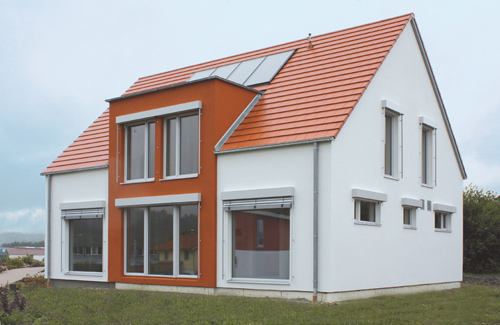Passive House is the highly energy efficient relatively new German method of building properties of all types. Every part of the building, from it’s windows and doors, to it’s heating and roofing is produced to a Passive House standard. According to website www.passive-house.co.uk their definition is: The Passive House (German: Passivhaus) is a voluntary building standard, that exceeds the present regulations by far. Built according to this standard the need for heating will be reduced by 90%. Compared to conventional build, which has an average heating demand of 150kWh/m2a, these homes need only 15kWh/m2a.
As the image above shows, for a building to be certified in the PassivHaus standard, windows have to be triple glazed with two of those panes being low e. This is good from a British point of view. If Passive House constructions start to take off, this is going to help boost the profile of triple glazing and also its sales.
Passive House also promotes other energy efficient methods that are trying to make their way into the mainstream. Take the ground heat exchanger underneath the property. More and more money and research is being done to take advantage of the heat that permeates up through our planet and under our feet. Ground heat exchangers and other similar methods are a much more efficient way of heating a home. Until the Earth’s core fails, then we’re buggered!
Passive House standards also rely on good ventilation in and our of the building which makes sure that there is enough cooling during the summer and heating during the winter so not to rely on mass radiator power. This way the building can breathe in a much more natural way. So when it comes to problems like damp, in theory it should never be a problem.
On top of that, the properties need to be super insulated. When you consider Passive Housing uses 90% less heating than conventional houses, you know the Germans are on to a winner. Again.
The only downside is the initial cost to build a house to such high standards. Triple glazing, ground heat exchangers, mega insulation etc isn’t cheap. The outlay in terms of £ compared to a standard built house is going to be quite a bit more. But I think in the long run the enormously cheap utility bills, super energy efficiency and quality build it is well worth it. I hope that Passive House building does catch on here as it will provide a welcome boost to associated industries.
To find out more, visit: http://www.passive-house.co.uk/index.php
PassivHaus Posts
April 2013
A Lesson In Passivhaus
I have tried my hand at Passivhaus before, attempting to write about the subject on some very basic knowledge and what I can pull out online. However, it's not been up to scratch. So, I [...]
March 2013
The UK Isn’t Ready For PassivHaus
For a quick guide to what PassivHaus is, click here to go straight my my own little resource about the building technique. There are a few reasons why I think PassivHaus isn't suited to the [...]
January 2012
>Are We Building Houses All Wrong?
>I never really took much interest in the Passivhaus energy standard. I saw it being talked about on Twitter a little bit, but took no notice of it. But I decided to take a look [...]




Social Media